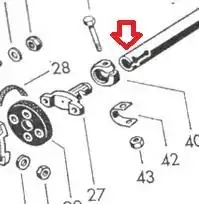On my more-or-less stock 1968 Vw Beetle...why is the steering wheel slipping (to a new position) in reference to the wheels...after installing (two) new TRW steering boxes?
I had the shop install a new adjustable beam and at the same time, a new TRW steering box. Immediately thereafter when I would turn the steering wheel at slow speeds (eg parallel parking, under heavy load), and then later drive, the steering wheel would have "slipped". I'd be going straight but the wheel would be 45 degrees to one way or the other. I found that if I stopped and turned it under heavy load the other direction I could get it to "slip" back to straight.
There was no problem with the steering before though. The problem occurred with first new TRW steering box. The shop said it was the steering box slipping internally. I had them install a second TRW (Brazilian). Still same problem.
There are dozens of suggestions on all of these forums, referenced below. But can someone answer what else could possibly be slipping for my following specific circumstances? Did I get two bad brand new TRW steering boxes? Is the shop incorrect in blaming the steering box, or is it entirely likely (historically probable) that it's the (two) new boxes?
Parts Name/Reference Image (albeit for 1961)
http://images.thesamba.com/vw/gallery/pix/461575.jpg
The steering box, beam, pitman arm, and everything from the pitman arm out to the wheels was replaced.
In 6 years of ownership, the original equipment never slipped before this upgrade.
It slips, and stays, in both directions. In other words, it's not just a flex.
Both wheels stay aligned afterward. No other unusual vibrations, shimmying, etc occur. (seems to rule out slipping at the wheel/ball joints).
The shop has "thoroughly" checked that nothing is visibly slipping, like on the input shaft or on the output shaft/pitman arm.
Inspection of the first "bad" steering box shows no fresh metal scraping on the shaft to suggest slipping over the splining (seems to rule out actual slipping at these junctions which otherwise seem the most likely).
The shop also seemed to think since the pitman arm installed doesn't have the steering stops that I was turning the wheels too far and going beyond the gear in the steering box, then coming back on a different thread. But this isn't what's happening because the problem occurs even with a very small turn of the wheel under higher load.
Thanks in advance for any ideas.
References:
Steering shaft slip (seems most likely?)
http://www.thesamba.com/vw/forum/viewtopic.php?t=595723
New steering box:
http://www.thesamba.com/vw/forum/viewtopic.php
Steering box slip?
http://www.thesamba.com/vw/forum/viewtopic.php
Steering box adjustment 67 bug
http://www.thesamba.com/vw/forum/viewtopic.php?t=609086
Steering wheel slipping on shaft
http://www.thesamba.com/vw/forum/viewtopic.php?p=6735090
TRW Steering Box
http://www.thesamba.com/vw/forum/viewtopic.php?t=243705
